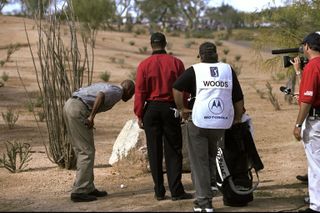The best way to answer this question about movable obstructions is to say that, while there are no specific dimensions mentioned, the wording of the definition of ‘movable obstruction’ in the Rules of Golf means there is an implied limit relating to either size or weight.
That definition says that a movable obstruction is “an obstruction that can be moved with reasonable effort and without damaging the obstruction or the course”. The Rules do not state by how many people but essentially, if it’s too big, cumbersome or heavy to be moved with reasonable effort, or doing so would likely damage either the course or the obstruction, then it has gone beyond being a movable obstruction as defined by the Rules of Golf.
This dropped jacket would be classed as a movable obstruction under the Rules
(Image credit: Kevin Murray)
This begs the question, what type of things are movable obstructions and how do they differ from loose impediments? Loose impediments are natural objects such as twigs, stones, leaves, acorns, branches etc, while movable obstructions are artificial objects that can be moved with reasonable effort. On a golf course, this would typically include things like water bottles, scorecards, drinks cans, towels, gloves, headcovers.

In this scenario, you remove the discarded coffee cup and if the ball moves you replace it
(Image credit: Kenny Smith)
Clearly, such items are all easily movable, although from a Rules perspective you do have to know the difference between how to proceed if they merely interfere with, or are close to, where your ball is lying, and when your ball has come to rest in or on such an item, more on which in a moment.
So, what kind of item might exceed the implied limit for a movable obstruction? It would be easy to bring up Tiger enlisting several fans to help him move a boulder in the 1999 Phoenix Open here, but that would be a mistake, because a boulder is not an artificial or man-made object. Ironically, it is classed as a loose impediment despite being anything but loose in a physical sense!

Tiger’s famous boulder in 1999 was a loose impediment not a movable obstruction
(Image credit: Getty Images)
Perhaps a good example of something exceeding the size or weight limit might be a bench that isn’t physically fixed but is either too heavy or too awkward for one or two people to move easily without damaging the course or the bench. The distinction between movable and immovable is important because the free relief available for…
..
Click Here to Read the Full Original Article at Golf Monthly…
